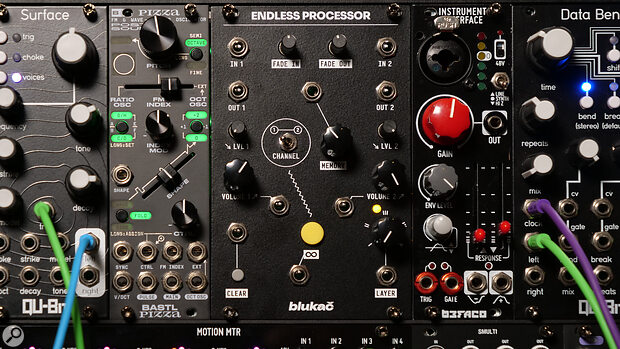The Endless Processor from Kyiv‑based Blukac does one thing. It takes a sound and sustains it to infinity. It’s such a simple thing that, initially, I felt a bit baffled and disappointed by it. Is that it? Surely there must be more than an eternally held note? But then it starts to undo you. Bafflement falls away and is replaced with mesmerisation. And when you resurface a few hours later after patching everything you own into it, you realise that this module is never leaving your rack.
As I say, the idea is simple enough. You plug in a sound source, Endless fills its buffer, and then you hit the big yellow button. At that moment, the sound is captured, resynthesized and smeared into the yawning forever. It’s not like a sample that loops; this is the dismantling and rebuilding of sound waves that are clicklessly encircled into a constant stream of frozen sound. One way of looking at it is that it generates a drone where the tone comes from the thing you’re playing.
A couple of unassuming but essential features open it up to vast possibilities. The first is that there are five layers of capture. So your drone invites some friends along, and soon a whole chorus of eternal voices are pulsing and swaying together. Each layer can be individually captured and replaced. A pair of Fade In and Fade Out knobs sets how quickly new captures emerge and old ones fade away. The other feature is that you have two channels of infinity to play with. So you can have two sound sources being captured independently, building up a huge soundscape of competing tones, again, utterly dependent on what you’re feeding into either side.
To take you through the process, a simple scenario would be to put the output of a sequenced oscillator into the top. A small level knob mixes the input signal with the output, and a larger knob governs the overall output of the channel. The signal fills the buffer before the level control, so you don’t have to hear the source at all, just the captured tones. The Memory knob in the middle sets the size of the buffer from very tiny to about 3 seconds. The effect of a long grab is quite interesting in that it might contain several notes or movements, creating a dense sound, but one that’s completely frozen, with each harmonic or texture sounding together. To capture the sound, you select a layer and hit the Infinity button. A moment later, according to the time set by the Fade knobs, the sound emerges and continues forever.
I’ve used it to capture drone notes from a sequence, controlling the yellow button from a trigger with a slow fade so it comes in like a bowed cello. I’ve built up chords by feeding it specific notes over several layers and then modulating the output level to create rhythms and stabs. It can fade in an entire soundscape behind a moving sequence that’s completely related to the sequence’s notes. It can then fade away and be replaced with something similar and yet strangely different depending on how the source has changed. You can, of course, feed it unrelated sounds. I found that routing a microphone into the Endless enabled me to build some fabulous vocal textures.
The drones by themselves can be a bit dry, so having some effects to hand is essential. A deep reverb, a washing of chorus, or the shake of a band‑pass filter will do wonders to animate the sound. There’s no pitch‑shifting in the Endless, which is perhaps one string missing from the bow of infinite sustain, so patching into pitch‑based effects can be very gratifying. As can adding modulation to the level controls to blend in some rhythms, tremolo or enveloped rises and falls. With a pair of LFOs you can crossfade between the two channels, which could simulate chord changes and texture variations.
What’s for sure is that this remarkable module has an eternal place in my modular.
The design is spacious, thoughtful and free from complications. You can build your whole system around feeding interesting things to the Endless Processor. Or you can leave it idly monitoring signals until the moment takes you to hit that button. Its ability to fill out space is extraordinary and very of the moment. What’s for sure is that this remarkable module has an eternal place in my modular.
£249
$300


